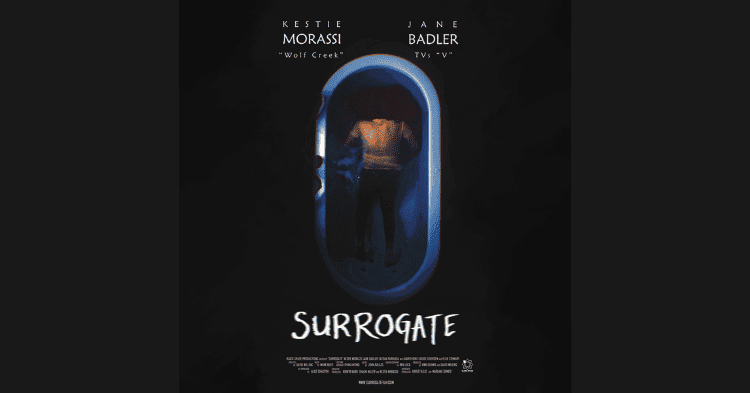In my last blog I detailed the Act 1 Story Architecture for Surrogate.
I received several emails from you asking for a breakdown of the 3 Act Structure Plot Points in Surrogates screenplay as I have done for other films in the past.
For an in-depth breakdown and explanation of the 3 Act Structure and the 4-5 Plot Points, watch the video below.
Below the video you’ll also find a quick overview of the 3 Act Structure for Surrogate.
Remember it is crucial for you to nail your structure so your screenplay works as a compelling story.
Logline
A ghost horror about Natalie Paxton, a single mother and nurse who falls mysteriously ill and struggles to stop her family from being destroyed.
Plot Point 1 – Inciting Incident
Natalie wakes in hospital after collapsing from internal bleeding. Dr Romero and Lauren Balmer (Jane Badler) who works for Child & Family Services quiz her about the previous 24 hours and if she’s sought medical attention at any other hospital.
Natalie is confused but they push her harder and tell her that she was pregnant. She insists she wasn’t but Dr Romero responds that she wasn’t only pregnant, all physical signs indicate she went full term and gave birth to a baby.
Surrogate’s Dramatic Question is
What caused the mysterious birth and how will Natalie survive the subsequent haunting?
Plot Point 2 – Act 1 Climax
This plot point is the scene in the hospital where Dr Romero informs Natalie that he’s at a complete loss as to what has happened to her medically.
He says there are plenty of documented cases of women experiencing a phantom pregnancy but the fact she went through labour and gave birth makes her a medical mystery.
For Natalie she can no longer deny that she went through labour but she has no understanding of why. She is unaware that this is just the beginning and the repercussions are going to dominate Act 2 of the story.
Plot Point 3 – Midpoint
After Rose is pushed down the stairs Natalie flees to the safety of her own mothers house. However when her mother dies in what appears to be an accident at the funeral Rose tells Natalie that the girl who is haunting them “came with us”.
Natalie can no longer avoid the danger, she must turn to face it and deal with it directly by embracing the irrational world of the paranormal.
Plot Point 4 – Act 2 Climax
Natalie uncovers the mystery of Lisa Bayer’s death and discovers her body under Mad Margot’s house. She believes that now Lisa’s body has been put to rest and justice served the haunting is over and Rose and her are now safe.
Plot Point 5 – Climax/Resolution
Natalie discovers the spirit of Lisa has in fact not gone and everything that has happened was part of Lisa’s twisted game. She is taunting Natalie to send her crazy to the point where she, like Mad Margot, will commit suicide and pass Lisa onto her next surrogate mother, thus continuing the endless cycle.
Realising this Natalie makes two painful choices at the story climax.
The first is to give her daughter Rose away to live with her brother as she will never be safe whilst Lisa is around.
The second choice is rather than end her pain by committing suicide she choses to live a reclusive life alone in her house and endure the ghost of Lisa for as long as her sanity can last.
3 Act Structure Overview
It is the classic story telling mode of
Act 1 – Beginning
Act 2 – Middle
Act 3 – End
Or
Act 1 – Set Up
Act 2 – Confrontation
Act 3 – Resolution
The 3 Acts are created and defined by 4-5 Plot Points which are:
- Inciting Incident
- 1st Act Climax
- Midpoint (optional)
- 2nd Act Climax
- Climax/Resolution
These Plot Points vary greatly and come in different intensities, contexts and forms depending on the story. These Plot Points need to appear on screen and for the overwhelming majority of stories the protagonist must experience them as they happen.
Inciting Incident
The event that throws the protagonists world out of balance. It comes in many forms including:
- Call To Adventure
- An Offer
- An Attack
- Life Changing Moment
- The End Of Something
- An Arrival
- A Departure
- The Discovery Of A Crime
Act 1 Climax
This is the 2nd major event in the story, it propels the protagonist into the confrontation and they struggle to achieve their goal. These scenes include:
- Point Of No Return
- Commitment To The Goal
- Major Set Back
- Major Victory
- Revelation
- Ticking Clock Begins
- Journey Commences
Midpoint
It’s also referred to as the Mid Act Climax of the story. Not all screenplays have this Plot Point but if they do it technically makes the story 4 Acts. In this moment the game changes for the protagonist and the stakes in the story are increased. Midpoints include:
- Major Loss
- Major Set Back
- Breakthrough
- Reversal
- New Plan
Act 2 Climax (Act 3 Climax in 4 Act Story)
The Protagonist has struggled and tried different methods for achieving their goal but they still haven’t achieved it so they will need a new plan or they will cross a final threshold into direct and full confrontation. This Plot Point includes:
- All Is Lost
- Protagonist At Their Lowest Point
- A Breakthrough
- Realisation
- The End Of Training
- Act 2 Plan Fails
Climax/Resolution
Also referred to as The Final Confrontation and in this moment the protagonist either achieves their goal (up ending) or fails (down ending). Common Climaxes are:
- Win The Battle
- Solve The Mystery
- Defeat The Villain
- Retrieve The Item
- Deliver The Item
- Apprehend The Killer
- Escape
- Arrive
- Right The Wrong
- Win The Court Case





